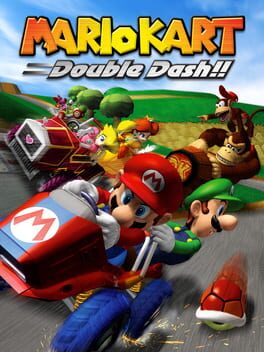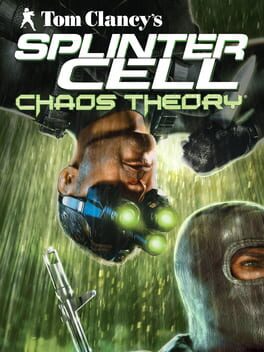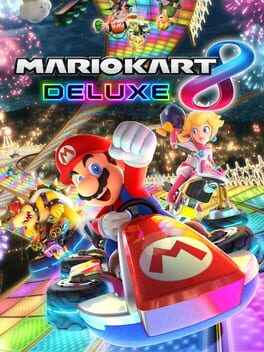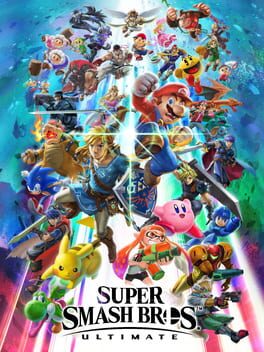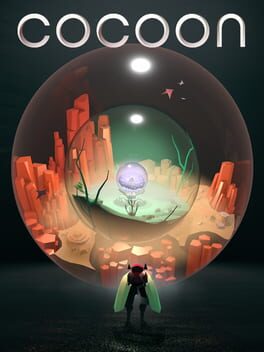Undercover
BACKER
In the process of rediscovering my love for this medium through this site. I used to play a lot until about 2013, but then drifted toward other interests. Now I’m getting back into games as a casual player. Also a fan of stealth games.
Badges

Busy Day
Journaled 5+ games in a single day

On Schedule
Journaled games once a day for a week straight

Loved
Gained 100+ total review likes

GOTY '23
Participated in the 2023 Game of the Year Event

Well Written
Gained 10+ likes on a single review

Gone Gold
Received 5+ likes on a review while featured on the front page

Pinged
Mentioned by another user

Liked
Gained 10+ total review likes

2 Years of Service
Being part of the Backloggd community for 2 years

Popular
Gained 15+ followers

GOTY '22
Participated in the 2022 Game of the Year Event

Shreked
Found the secret ogre page

Donor
Liked 50+ reviews / lists

Roadtrip
Voted for at least 3 features on the roadmap

Best Friends
Become mutual friends with at least 3 others

Noticed
Gained 3+ followers

Gamer
Played 250+ games

Organized
Created a list folder with 5+ lists

N00b
Played 100+ games
Favorite Games
318
Total Games Played
012
Played in 2024
204
Games Backloggd
Recently Played See More
Recently Reviewed See More
Spin-off games are always an ambivalent proposition. At worst, they are nothing but a cheap marketing stunt, a simple act of slapping the looks and sounds of an already lucrative IP onto what would otherwise be a completely unrelated experience. In their best instances, however, spin-off titles are not only good games in their own right, but can also offer unique insight into the main series they’re based on that is as valuable as any written or video analysis of these games. Given that almost every mobile game falls into the former category of half-assed corporate branding, it is all the more remarkable how elegantly Hitman GO achieves the latter.
The premise of Hitman GO is that Hitman can naturally be adapted as a turn-based puzzle game because the core experience of the series has always been akin to puzzle solving anyway. The same can actually be stated for most other stealth games. Both genres generally share a principle of pull game design, where the game initially rests in a passive state that can be manipulated by the player character. In both cases, the world usually does not act independently from the player, its elements only change in periodic time loops at most until you interact with them. From this perspective, there really isn’t that much of a difference between figuring out the routes of patrolling guards and, say, the functioning of a control room puzzle. Both behave in an entirely predetermined and predictable manner, which the player is encouraged to carefully observe before making an informed decision about how to influence them to their advantage.
The main differences lie in how you are able to collect the information and how the games react to your mistakes. In stealth games, information gathering is already part of the same hide-and-seek dynamic that characterizes their progression system as a whole. Players are bound to the limited perspective of their character, which can be expanded by all sorts of enhanced movement capabilities or item usage. Abilities, that also often put them at risk of discovery, in which case the game shifts gears to a push dynamic that puts the player at a disadvantage until they manage to escape detection again. All these elements are not present in most puzzle games, but they also aren’t equally relevant to all stealth games, and I think that Hitman GO is right to argue that they are an expandable part of the Hitman series. Though the games have always provided you with a surprisingly large array of lethal options, they also clearly incentivize you to play in a specific, non-confrontational manner. Every good Hitman level has one or several ideal methods of assassinating your targets that make their deaths look like accidents and that require a deep understanding of the level design to work out. A perfect rating further requires you to execute the whole plan without any casualties or getting spotted, like you were never even there in the first place.
All the guns and melee weapons offer less of an equally valid alternative, and more like something to keep players entertained until they have figured out a more optimal method (hence their inherent ability to generate slapstick moments), or as a last resort brute force approach if they can’t. This is why the multiple film adaptations feel like such a grotesque misinterpretation of the games they are supposed to be based on. As if the filmmakers only bothered to engage with the most surface level promotional material of a menacing looking bald guy with dual wielding pistols, the perfect protagonist for any generic action film. Hitman GO instead gets to the core of the experience, by adapting the basic progression structure in its level design.
Each of the five main levels takes the shape of a board game that represents a specific location – usually an expansive mansion –, in which two red targets are placed as figurines to assassinate, one at the halfway mark and one at the end point of the map. The progress of your figure through this overworld is marked by a linear path with fifteen steps, mimicking the actual route of infiltration a player might take in a 3D-environment – entering from the garden across the pool house to the tennis court for the first kill, then sneaking their way through the greenhouse into the main building for the second, for example. Every step takes you to a different sub-screen of the individual puzzles, with a more detailed illustration of the current area, but this time your goal is behind multiple branching paths, patrolling guards and various items. This subdivision also perfectly captures how Hitman levels are never just free-roaming open worlds, but a complex series of subsequent or interlocking stealth challenges with restricted areas within restricted areas. In fact, the developers were even able to directly adapt two levels from the main games into additional boards later on, both of which translate beautifully into the new formular.
The puzzles themselves are as close to stealth gameplay as a turn-based board game can be, save for the aforementioned aspects of information gathering and improvisation under detection. You always have perfect information about the position, movement, and possible interactions of every element on the board, to the point where it is theoretically possible to solve most of the puzzles in your head before you even make your first move. There is absolutely no ambiguity or chance involved in the outcome of every turn: If you move onto a field in sight and proximity of a guard, you lose. Detection is equal to immediate failure. These conditions might feel restrictive for other stealth games like the Metal Gear series, which puts a much higher emphasis on improvisational tactics and emergent gameplay (the turn-based card gameplay of the Acid games definitely offer a more apt interpretation here), but they are a perfect fit for Hitman.
The completely formalized spacial and temporal interactions on the puzzle board actually correspond to the natural tendency for abstraction that differentiates stealth games from the majority of 3D genres. Where most games try to immerse you in a believable world, stealth encourages a more detached analytical perspective that pays attention to the structure behind the appearance. For instance, lighting becomes less of a tool for generating atmosphere and more an indication of save areas. And while the question of light and shadow is not particularly important to Hitman, its disguise system arguably offers an even more radical example for the same principle. It makes you incentivized to see every character not as an individual but merely an anonymous avatar playing a social role, who can be perfectly imitated and replaced at all times. Is there a better way to emulate the point of view of a cold-blooded assassin?
As such, the Hitman series was only ever interested in simulating social situations insofar as they communicate a clear signification. Hitman GO even manages to capture this aspect in its twofold implications. On the one hand, the guards on the board all behave in a specific manner determined by the color of their uniform. Some always rest in the same position until distracted, others turn around every turn or patrol along a linear path. Circumventing these obstacles mainly revolves around questions of move order and timing. On the other hand, there are civilians on the side of the boards, freezed in different tableaux vivants that display snapshots of social configurations: a gardener resting in the shade of a tall hedge; or a man all alone in the backrow of a wedding ceremony, burying his face in his hands.
I would even go as far as saying that Hitman GO was crucial for getting the series back on track after the confused mess that was Absolution. Square Enix Montreal certainly had a deeper understanding of Hitman than IO Interactive at that point. Still, in spite of all my praise for how Hitman GO interprets the games it is based on, one central part of the puzzle is missing. A crucial factor of the perverse appeal of the Hitman series is that you have to perform the process of abstraction yourself. Every new level sure looks like a natural environment at the start, until you peel away its different layers of artificial reality to the point where there is nothing left but a perfect clockwork leading your targets to their ultimate destiny. You almost feel like a sort of sadistic god of fate at the end, enacting a twisted higher judgment on your victims. The final execution is only the last part of this process, and not exactly the most engaging one as it usually involves a lot of waiting for every piece to fall into place. Hitman GO already strips away too many layers of social artifice for you. What is left is a series of good, but not great puzzles that have more to say about one of the best series of my favorite genre than they are able to speak for themselves.
__________________
More puzzle game reviews
Chants of Sennaar
Cocoon
Mole Mania
To give just one example: There are these tiny, pyramid-shaped flying things that temporarily accompany you throughout the game and are used to open certain barriers, thus resembling a sort of remote control. But the same robotic assistants are created out of some amorphic floating liquid that shapes into an amber-like crystal before being shattered to give “birth” to them like a fossilized insect. And at some point, other floating things appear that can trap your little companions with a sticky substance, as if they are carnivorous plants that act as natural enemies, even though they can themselves be remotely controlled on predetermined paths by the player character. Cocoon constantly undermines any effort to adequately organize its sights and sounds, most notably with its central feature of traveling between worlds within worlds, a mechanic that literally forces you to inverse your previous sense of proportions and causation on a routine basis.
Mechanically, however, Cocoon is translucently unambiguous. As confusing as the jump into and out of the different worlds may be visually, it rarely leaves you stranded about what to do next. Progression is completely linear, with only the occasional branching path that leads to a dead end after a few steps. Every new problem is presented in a way that makes it immediately obvious what you need to achieve, just as all the tools and obstacles on your way are distinctly highlighted. Consider again your little pyramid-shaped companions. A beam of light shines from the tip of the pyramid which automatically points you to your next objective. Once they reach their corresponding obstacle, a little animation is triggered which makes the obstacle glow as well before it starts moving. The same beam starts to flicker when they get close to their enemy. Finally, they disappear again as soon as their purpose is fulfilled. Although it is never explained what this thing is or why it works the way it does, the question how it works never really arises.
The same is true for every single element in the game: Buttons open doors or move platforms, pressure plates need a weight on them to stay activated, pipes are used to transport orbs etc. And since there is only one action button, you are never in doubt about how to interact with the various objects as well. Even the bosses reliably follow a pre-established rulebook. Every boss first introduces itself in a scripted sequence, before challenging you at the end of its respective segment where it takes every precaution to telegraph its attacks and reveal its weak spot as clearly as possible during the fight. I never got hit on my first try in any of these encounters, which pretty much never happened to me before. In short, you have any prior experience with puzzles from other games, there are almost no surprises here. The game isn’t even all that difficult. Puzzles might technically get very complex and abstract towards the end, but they are always structured in a way that splits the challenges up into multiple smaller segments with only a handful of variables to work with. For most of the playtime, the solution presents itself almost as naturally as all the other elements.
By all accounts, these two contradictory approaches to aesthetics and gameplay should all but negate each other. Instead, the unique quality of Cocoon arises from the tension between them. It captures an experience of immense uncertainty about the fundamental conditions of the world – what things are and why they exist –, but at the same time gives you an almost instinctive understanding of how to work with them. Crucially, most puzzles play out less stimulating than arduous. This is by no means meant as a criticism. It simply describes the basic condition of the character, who is constantly working by carrying around these orbs more than twice their size on their back, taking part in a process where the next step is always logical enough to take it almost automatically, while both the originating cause and ultimate goal of your actions are infinitely removed from your grasp – along with all the curiosity and excitement as well as uneasiness and distress this process implies. The only thing that was somewhat clear to me throughout the adventure was that my actions were somehow driving forward some kind of evolutionary process. But whose evolution I was contributing to or to what ends is left almost completely open to speculation. Your role is just to bear witness to a gradual accumulation of energy and power, which progressively involves everything from the tiniest insects to the most elemental forces of the universe.
__________________
More puzzle game reviews
Chants of Sennaar
Hitman GO
Mole Mania
The game is at its most engaging at the start of each chapter, when you encounter a lot of still unknown signs of a new language at once and in various contexts, without any one of them offering conclusive evidence to their exact meaning. You observe the same symbols appearing in different combinations: there in a dialogue between two other NPC’s, here directly addressed at your character, and yet another time as part of a title for a painting on the wall, for instance. The comparison between the respective utterances sometimes leads you to more or less educated guesses about the meaning of individual words. This approach is greatly encouraged by the game’s single best system, which lets you write down your interpretations in an in-game notebook. These hypothetical translations then appear every time you encounter the corresponding sign from that point onward. You type in your definition and return to the same situations to see if they make more sense now. Some dialogue might suddenly transport a meaning that lets you infer even more translations, while other texts appear to be off just ever so slightly which forces you to adjust your hypothesis.
This simple gameplay loop is the beating heart of Chants of Sennaar and it would have been more than enough to sustain the whole game. That’s because the process of translating any given word is rarely just a matter of choosing the right or wrong answer to a question. Sometimes, there may be several possibilities that all make sense in every example available to you. At other times, there perhaps is no single completely accurate translation for the language you are playing the game in, or the meaning itself might vary, depending on the specific context of usage. None of the five languages in the game may seem very complex with only thirty-something words each to decipher, but ambivalences and ambiguities arise naturally when these symbols are transferred into your own language and its almost infinite semantic complexity.
Things get even more interesting when you start to translate between the in-game languages. Despite their limited vocabulary, the game introduces several layers of deviation that go beyond a mere terminological equivalence of all languages. It starts with small differences, such as the indication of plural forms, but later on new languages will have entirely different sentence structures, making it almost impossible to translate them word by word. Even in cases of denotative correspondence, the terms still can hold opposite connotations. For example, the Warrior’s term to refer to the group of the Devotees carries a strictly pejorative meaning.
In general, the process of learning a new language always provides insight into the culture of the respective group. If only the Alchemists have a decimal system in their vocabulary, then because they are the only ones who frequently need to operate with exact figures. This distinction is further underlined by the fact that their words are usually composed of abstract geometric shapes, while other groups like the Devotees use a more figurative sign language. Also note how every language is taught you to differently, according to the speaker’s culture. It makes perfect sense that you learn the language of the Devotees by their religious teachings, while the Warriors mainly communicate through orders, or that the Bards express their concepts in theatre plays and the Alchemists in scientific formulars. If you stay attentive to these indicators of social structure, you’ll find that there are conversely multiple ways to decipher the languages. Every written language follows its own inherent visual logic, which usually makes it possible to differentiate between different types of words prior to knowing their exact meaning.
Chants of Sennaar deserves most of the praise it is getting for how much sophistication it creates with its simple translation mechanics. I want to make clear that these qualities are not simply outweighed by its faults before diving into the next paragraphs full of criticisms. In fact, my main frustration with the game stems from how much other stuff was added, even though it contributes almost nothing to the experience. Basically, every element that is not directly linked to the act of translating remains awfully underdeveloped, and there is surprisingly much of it. Throughout the adventure, you’ll encounter block puzzles, several labyrinths, platforming, even scripted chase sequences and some embarrassingly misplaced horror moments. The real problem with the stealth sections therefore becomes that they are only the most prominent sample of a much wider array of poor gameplay segments throughout the whole game. Why in the world is there a Flappy Bird mini game in here?
Besides being a distraction from the game’s strengths, these components also sometimes work against them. Despite language being the central feature of the experience, the world is, for the most part, curiously devoid of its presence. Instead of creating a series of dense and intimate social spaces to explore, Chants of Sennaar tries way too hard to give your adventure a grandiose sense of scale of Babylonian proportions. As a result, you mostly traverse through wide, empty spaces with only a few scraps of text to be found each area. Far too much time is spent by just walking from one point of interest to the next, and the whole layout of the tower quickly becomes so confusing that it actually discourages you from revisiting old areas to test out your hypothetical translations, regardless of the fact that this method is incentivized by the mechanics.
Above all, the bloated emptiness and stuffed gameplay features for the sake of variety make apparent a certain lack of confidence by the developers in their own genuine systems, which shines through in the design of the core mechanics as well. I completely understand the reasons behind the decision to give official, “correct” translations to every sign, especially from a practical perspective. Periodic tests of your knowledge that gradually verify the meaning of each word were probably necessary for the steady pace of progression the story aims for, without running the risk of some players getting hopelessly lost in translation at some point. The tests themselves also mostly avoid the trap of giving away the answer too easily by making you translate multiple signs at once. Yet the drawings used to illustrate the supposed “proper” sense of the corresponding word are themselves the perfect illustration for why this correspondence between signifier and signified is itself impossible.
As individual sketches, these drawings are usually inept to represent the whole range of a sign’s meaning, especially if they are meant to visualize abstract concepts. To merely criticize this, however, would miss the point that the drawings do not actually attempt to provide a definition themselves, but to facilitate the process of translating the in-game languages into your own. In fact, the use of drawings sidesteps the much more rigid method of a direct verification through your own native tongue. If the game would ask you to formulate the translation directly, it would need to account for many possible “correct” inputs from the player. Even something as seemingly simple like the sign for “I” could also be translated with words such as “me”, “myself”, “my”, “oneself”, “selfhood” etc., depending on the sentence in which it was used. The options only multiply when you take more than the English-speaking audience into account. Instead, the drawings try to be consistent with all your possible hypotheses about the specific meaning of a sign, before arbitrarily deciding the “true” translation once you associate it correctly with the drawing. These official translations remain somewhat flexible, as the game will for example conjugate verbs according to the context of a sentence.
Yet despite every precaution taken to make it less restrictive, this system still asserts clarity and plainness where there was ambiguity and complexity before. No matter how different the process of translation was for each player, Chants of Sennaar makes sure that everyone arrives at the same conclusion at the end. The price of this approach is that once any sense of ambivalence about a word’s meaning is resolved, your translations stop being a tool you use creatively to understand unknown signs, and simply start to replace the foreign language, which in turn ceases to matter once it becomes “solved”. The goal is not really to learn a previously unknown language, but to reinstate the transparency of your own language into the world. Understanding a language has little to do with being able to find correspondences between another one already familiar to you. True understanding can only be reached inside the language itself.
Of course, this process takes years with any language in the real world and might seem like a tall task to ask for a puzzle game that only takes a couple of hours to beat. But I’d argue that games have been remarkably good at making you learn to think in ways that even make almost zero sense outside the experience. Think of Portal’s catchphrase “now you’re thinking with portals”, which is another way of saying that you have become a fluent speaker in the use of portals. Every good puzzle game adheres to this core design principle in its own way. They are never simply about solving a series of well-designed problems; they also gradually augment your way of seeing and interacting with its world in a way that make these problems solvable in the first place. In comparison, Chants of Sennaar is oddly reluctant to let you use the languages you learnt for yourself. The game could have linked progression to successfully communicating with the natives, or by acting as a translator between them. While the latter is in fact the penultimate and certainly most rewarding challenge the game presents, it is also inexplicably demoted in its entirety to a side quest to reach the “true” ending. For the most part, Chants of Sennaar wants you to learn its languages not to understand or use them yourself, but rather to enable you to understand its other mechanics, even though these are already so derivative of other games that they should require the least explaining of all.
__________________
More puzzle game reviews
Cocoon
Hitman GO
Mole Mania
